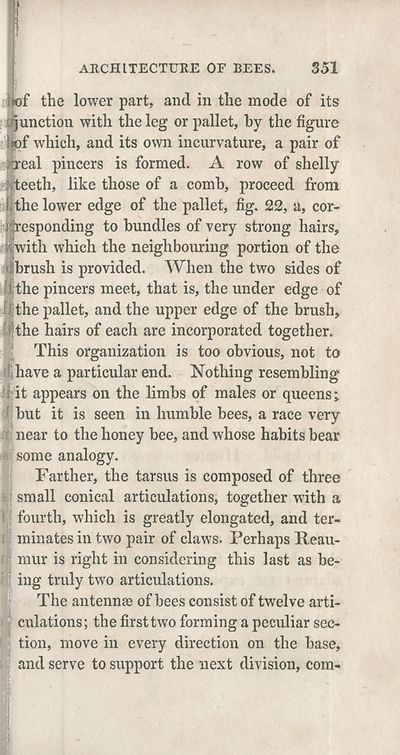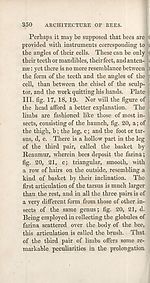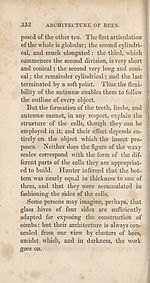Download files
Complete book:
Individual page:
Thumbnail gallery: Grid view | List view

ARCHITECTURE OF BEES. 351
of the lower part, and in the mode of its
»j unction with the leg or pallet, by the figure
liof which, and its own incurvature, a pair of
areal pincers is formed. A row of shelly
ateeth, like those of a comb, proceed from
fithe lower edge of the pallet, fig. 22, a, cor-
; fresponding to bundles of very strong hairs,
rtwith which the neighbouring portion of the
dbrush is provided. When the two sides of
(tthe pincers meet, that is, the under edge of
Jljthe pallet, and the upper edge of the brush,
[fthe hairs of each are incorporated together.
I This organization is too obvious, not to
4 have a particular end. Nothing resembling
i it appears on the limbs of males or queens;
J but it is seen in humble bees, a race very
t near to the honey bee, and whose habits bear
a some analogy.
Farther, the tarsus is composed of three
: small conical articulations, together with a
1! fourth, which is greatly elongated, and ter-
i minates in two pair of claws. Perhaps Iteau-
r mur is right in considering this last as be-
t ing truly two articulations.
The antennae of bees consist of twelve arti-
i' cnlations; the first two forming a peculiar sec-
‘; tion, move in every direction on the base,
; and serve to support the next division, com-
of the lower part, and in the mode of its
»j unction with the leg or pallet, by the figure
liof which, and its own incurvature, a pair of
areal pincers is formed. A row of shelly
ateeth, like those of a comb, proceed from
fithe lower edge of the pallet, fig. 22, a, cor-
; fresponding to bundles of very strong hairs,
rtwith which the neighbouring portion of the
dbrush is provided. When the two sides of
(tthe pincers meet, that is, the under edge of
Jljthe pallet, and the upper edge of the brush,
[fthe hairs of each are incorporated together.
I This organization is too obvious, not to
4 have a particular end. Nothing resembling
i it appears on the limbs of males or queens;
J but it is seen in humble bees, a race very
t near to the honey bee, and whose habits bear
a some analogy.
Farther, the tarsus is composed of three
: small conical articulations, together with a
1! fourth, which is greatly elongated, and ter-
i minates in two pair of claws. Perhaps Iteau-
r mur is right in considering this last as be-
t ing truly two articulations.
The antennae of bees consist of twelve arti-
i' cnlations; the first two forming a peculiar sec-
‘; tion, move in every direction on the base,
; and serve to support the next division, com-
Set display mode to:
![]() Universal Viewer |
Universal Viewer | ![]() Mirador |
Large image | Transcription
Mirador |
Large image | Transcription
| Antiquarian books of Scotland > Curiosities & wonders > New observations on the natural history of bees > (377) |
|---|
| Permanent URL | https://digital.nls.uk/128810391 |
|---|
| Description | Thousands of printed books from the Antiquarian Books of Scotland collection which dates from 1641 to the 1980s. The collection consists of 14,800 books which were published in Scotland or have a Scottish connection, e.g. through the author, printer or owner. Subjects covered include sport, education, diseases, adventure, occupations, Jacobites, politics and religion. Among the 29 languages represented are English, Gaelic, Italian, French, Russian and Swedish. |
|---|

